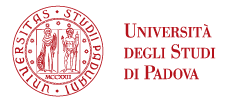Presentation
MAPS is the Italian acronym for Department of Animal Medicine, Production and Health. It was established in 2012 as a result of the merger of the following departments: Veterinary clinical sciences, Veterinary experimental sciences, Animal Sciences and Public health, comparative pathology and veterinary hygiene. It is now an integral part of the School of Agricultural Sciences and Veterinary Medicine.
MAPS' mission
Among the Department's objectives are the training of veterinarians and the continuous updating of veterinary professionals' knowledge. In fact, veterinarians must have a sound knowledge of the various veterinary disciplines, ranging from adopting a clinical and zootechnical approach to being an expert in communicable diseases (either infectious or parasitic) or feed. These qualities require specific competencies and a deep understanding of the stock-farming sector, animal behaviours (including the relationship between animals and human beings), the welfare of farm and companion animals, the control of infectious and parasitic diseases (including diseases transmissible to humans), as well as of food hygiene and safety. It is for the these reasons that MAPS was created, together with the assumption that before practicing the veterinary professions, graduates of veterinary medicine shall successfully pass a national examination on various areas.
MAPS' organization
MAPS' organization is mainly based on two pillars: veterinary medicine and research.
Whereas the first pillar allows the training of veterinary students through a number of disciplines and by combining both theoretical and practical activities, the second one ensures graduates are able to meet the constantly evolving health, economic and social needs.
Among the educational and research objectives of subjects such as farm and companion animals welfare (which are becoming increasingly important) are the protection of the public health, the control of animal and human transmissible diseases, the implementation of hygiene and food safety rules.
The guideline that connects these two pillars and defines today's veterinary practice is the One Health concept. Building on the integration of different disciplines, it is necessary to acknowledge that the health of humans, animals and the ecosystem are connected.
Where is MAPS located?
The Department is located on the Campus of Agripolis in Legnaro. In addition to MAPS, the campus also hosts the following departments: BCA, DAFNAE, TESAF, and the School of Agricultural Sciences and Veterinary Medicine. On campus are also the facilities and equipment necessary for the continuous training of students, teachers and staff. Amongst the services and facilities of MAPS, a special mention should be made to the VTH (OVUD), which plays a key role as it allows veterinary students to carry out their Tirocinio.
MAPS laboratories are also a crucial component of the Department. Here technicians provide support in research and teaching activities, and play an active role in the so-called third mission, thanks to the various OVUD services, local veterinary professionals and the citizens, who are the service users.
Finally, spaces intended for the hospitalization and isolation of infected animals allow to study and use animals for teaching purposes. These spaces have biosafety levels BL2/BL3 for the isolation, treatment and in vivo study of infectious diseases, including zoonoses and parasitic diseases. Moreover, they are also used for the performance of surgical operations, which aim at supporting the scientific activities of university researchers through in vivo research, in compliance with EEC directives as transposed in Legislative Decree No. 26/2014.
This is OVUD. If you wish to visit the OVUD website, please click here.
These facilities are intended for the hospitalisation and isolation of infected animals.
Laboratory activities are very well established. Here you can find a list of MAPS laboratories.
For MAPS services, please click here.





